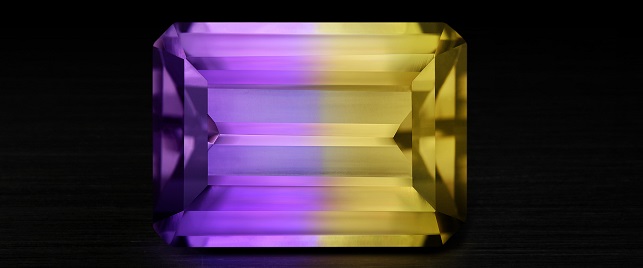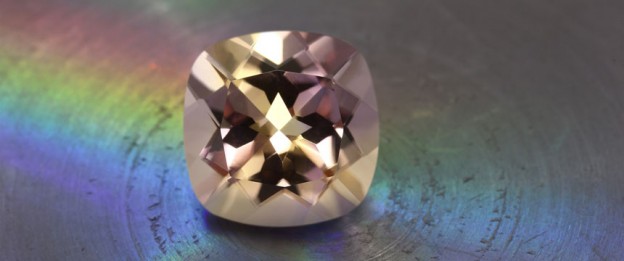A natural multi-coloured stone
The Bolivianita aka Ametrine is a precious gemstone that clearly shows two different colours: violet and yellow, in one stone, made its appearance in the 1980s. The gemstone didn’t have the success it deserved for its debut. It took a few years of geological research in the region of origin to document that it was indeed a naturally formed two-colour gem, without any artificial treatment. From the 1990s onwards, Bolivianite, also known as Ametrino, began its ascent in the world of precious stones. Only in the last decade, did the stone finally become noticeably present in high-end jewellery, becoming part of important collections around the world. Among the many high-profile, women who wear jewellery with Bolivianita are Queen Sofia of Spain, Princess Michiko of Japan and Hollywood actress Salma Hayek.

Sunburst Ametrine
A fusion of two treasures: Amethyst and Citrine
What causes the rare effect of two different colours, clearly divided in the same gemstone is the fusion of two precious stones: Amethyst and Citrine. This is due to the difference in the oxidation of iron as a colouring element within the quartz structure. Amethyst and Citrine belong to the family of macrocrystalline Quartzes. The colour variation is due to their iron elements. Very complex geological phenomena have given rise to this formation that is extracted only in Bolivia. The most important Ametrine mine is the Anahi, located, in the Province of Santa Cruz, some 220 km from the town of Puerto Suarez, in the heart of the jungle.
Myths and Legends…
While researching this fascinating work of nature, I learned that the raw gemstone had been known for centuries by the natives of the area who belonged to the Ayoreo tribe. And here comes the surprising legend. There are actually two different versions are known. The first is a story of the Ayorea princess Anahi, who was very beautiful and caught the attention of a conqueror of the Castizo (indigenous people) named Don Felipe de Urriola y Goitía. He took her as his wife in marriage. However, when the Ayoreo people learned that Don Felipe was planning to return to Spain and take his wife with him, they decided to kill him to prevent him from taking Anahi. She learned of the plot and helped her consort escape, paying for her boldness with her own life. She died in her husband’s arms, but before dying, she gave him a piece of a crystal of rare beauty, with two different colours, a Bolivianite, representing the divided love between her husband and her people. The conqueror managed to return to Spain, and the piece of stone accompanied him as an amulet until his death many years later.

Ametrine
Another story
The second version is that of an Ayoreo tribal princess named Anahi, who was very beautiful, with violet eyes with strong yellow sparkles. On a walk through the Anahi jungle, she met her alarmed subjects, who told him that enemies had arrived in the area on very white horses, wearing metal suits armed with metal objects that spat fire. They begged the princess to hide for her own safety. Instead of hiding, the princess ran to her village to give the news to her father, who was the chief of the tribe… but when the princess was narrating the news the conquerors arrived on horseback, in armour and began to destroy of everything that was in their way. The princess was mortally wounded, dying in her father’s arms. From that day on, Anahi’s father carried a Bolivian crystal with him that symbolized the love for his people, that was as strong as the love for his brave beautiful daughter.
I couldn’t find out the reason for the two versions but I found it interesting and fun to tell you the different stories.
Bolivianita/Ametrine today
For now, the main Bolivianita export markets, according to Rodolfo Meyer, owner of the largest exporting company in the field, are the United States, France, Germany, and some Asian countries. Bolivian gemstone sales abroad have almost doubled in the last two years.

Piedra Ametrine
Ametrine/Bolivianite
According to the Institute of Foreign Trade, in 2012 these Bolivian gems sales totalled 49.2 million dollars, while in March of this year they reached 95.2 million dollars.
Bolivianita is now considered the emblem of Bolivia and a law was enacted in 2009 prohibiting the export of raw gems. It is only possible to import cut and carved gemstones from Bolivia.





